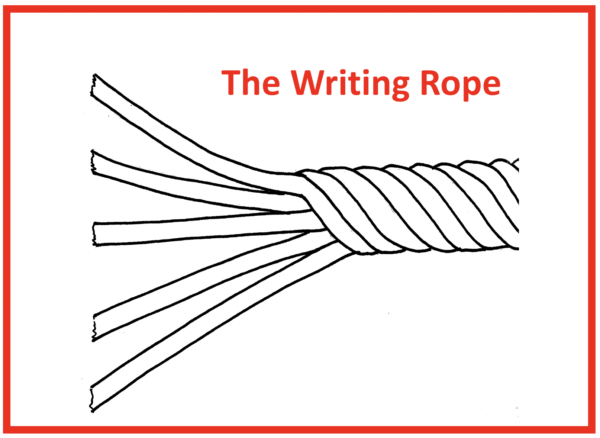We Need a “Writing Rope”!

The literature and discourse related to literacy instruction tends to focus on reading, even though writing is just as important for student literacy achievement. In addition, significant attention is paid to the multi component nature of skilled reading, while writing tends to be referred to as a single, monolithic skill.
Much has been written about the multiplicity of skills involved in reading, beginning with the “five components” model that became popular after the 2000 report of the National Reading Panel (i.e., phonemic awareness, phonics, fluency, vocabulary, comprehension). Levels of language skills are often referred to in terms of how they contribute to skilled reading (i.e., phonology, orthography, morphology, syntax, semantics, discourse). School assessment plans typically organize formal and informal measures around the discreet reading skills that they measure (e.g., phonemic awareness, word or passage oral reading fluency, vocabulary knowledge, sentence or passage reading comprehension). Some published reading programs focus on specific reading components by design (e.g., phonological awareness programs for young children, phonics programs for the primary grades) and core reading programs identify how discreet reading skills are addressed in daily or weekly lessons.
On the other hand, when attention is paid to writing instruction, teachers are not sure what that should include. Many educators who are knowledgeable about effective reading instruction are stymied when asked to: (1) identify the components of skilled writing, (2) explain how levels of language contribute to skilled writing, (3) identify a set of writing assessments, or (4) suggest a comprehensive curriculum for teaching writing.
With a nod towards Hollis Scarborough’s “Reading Rope”, in 2019 I developed a model that identifies the multiple components that are necessary for skilled writing: The Writing Rope: The Strands That Are Woven Into Skilled Writing. In 2001, Scarborough published a graphic that depicts multiple components of language comprehension (i.e., background knowledge, vocabulary, language structures, verbal reasoning, literacy knowledge) and word recognition (i.e., phonological awareness, decoding, sight recognition) as strands in a rope. As students develop skills in these components they become increasingly strategic and automatic in their application, leading to fluent reading comprehension.
A similar “rope” metaphor can be used to depict the many strands that contribute to fluent, skilled writing, as shown in the graphic below. It should be noted that instruction for many skills that support writing also support reading comprehension.
For a more detailed explanation of the “writing rope”, see my December 1, 2019 article “The Strands That Are Woven Into Skilled Reading” available at the Free Resources part of the Keys to Literacy website. For a PDF of the graphic, click here.


 Joan Sedita is the founder of Keys to Literacy and author of the Keys to Literacy professional development programs. She is an experienced educator, nationally recognized speaker and teacher trainer. She has worked for over 35 years in the literacy education field and has presented to thousands of teachers and related professionals at schools, colleges, clinics, and professional conferences.
Joan Sedita is the founder of Keys to Literacy and author of the Keys to Literacy professional development programs. She is an experienced educator, nationally recognized speaker and teacher trainer. She has worked for over 35 years in the literacy education field and has presented to thousands of teachers and related professionals at schools, colleges, clinics, and professional conferences.
Joan, Joan, Joan. You are right! We needed it! Thank you is not enough.
Thanks Ilda!
Great idea for a visual, Joan!!
I love this!!
This reminds me of the six traits of writing that I used to teach writing to my fourth grade students for so many years.